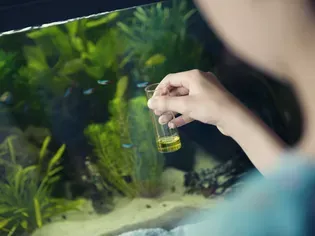How to Do Aquarium Water Changes
Updated on 04/26/24

Master the Art of Aquarium Water Changes: A Comprehensive Guide
Introduction
Maintaining pristine water conditions is paramount for the health and well-being of your aquatic inhabitants. Aquarium water changes play a crucial role in this regard, effectively removing waste products, replenishing essential minerals, and keeping water parameters stable. However, executing water changes can be a daunting task, especially for novice aquarists. In this comprehensive guide, we'll delve into the intricacies of aquarium water changes, empowering you to master this essential maintenance procedure with confidence.
Importance of Aquarium Water Changes
Just like you and I need fresh air and clean water, your fish and other aquarium inhabitants require pristine water conditions to thrive. Aquarium water changes accomplish several vital functions:
* Waste Removal: Fish excrete ammonia and other waste products into the water. Water changes remove these harmful substances, preventing their accumulation and potential harm to your aquatic pets.
* Mineral Replenishment: Water changes replenish essential minerals that are gradually depleted over time. These minerals are crucial for fish health, growth, and reproduction.
* Water Parameter Stability: Water changes help maintain stable pH, hardness, and other water parameters within the optimal range for your aquatic species.
How Often Should You Change Aquarium Water?
The frequency of water changes depends on several factors, including the size of your aquarium, the number and type of fish you keep, and your filtration system. As a general rule of thumb:
* Small Aquariums (Under 20 Gallons): Weekly 20-25% water changes
* Medium Aquariums (20-50 Gallons): Biweekly 20-25% water changes
* Large Aquariums (Over 50 Gallons): Monthly 15-20% water changes
Step-by-Step Guide to Aquarium Water Changes
1. Gather Your Equipment: You'll need a clean bucket, siphon or pump, water conditioner, and a thermometer.
2. Prepare the New Water: Fill the bucket with tap water and treat it with water conditioner to remove harmful chlorine or chloramine.
3. Siphon Out Old Water: Use the siphon or pump to remove a portion of the old water from the aquarium. Avoid disturbing the substrate or plants.
4. Add New Water: Slowly pour the prepared water into the aquarium, matching the temperature of the old water to avoid temperature shock.
5. Monitor Water Parameters: Use test kits to check the pH, ammonia, nitrite, and nitrate levels after the water change to ensure they remain within the acceptable range.
Tips for Effective Water Changes
* Avoid Overcleaning: Overcleaning can disrupt the delicate balance of your aquarium's ecosystem. Stick to the recommended water change frequency and don't remove too much water at once.
* Use a Gravel Vacuum: A gravel vacuum can be helpful in removing excess debris and waste from the substrate.
* Maintain Filter Efficiency: Regular filter cleanings and replacements are crucial for maintaining water quality.
* Monitor Fish Behavior: Observe your fish closely after a water change. Any unusual behavior, such as lethargy or gasping for air, could indicate a problem with the new water or the water change process.
Examples of the Benefits of Aquarium Water Changes
* Improved Fish Health: Regular water changes reduce stress, prevent diseases, and promote a healthy immune system for your fish.
* Vibrant Plant Growth: Stable water parameters and a lack of harmful waste products create an optimal environment for aquatic plants, leading to lush growth and vibrant colors.
* Clearer Water: Water changes remove suspended particles and algae, resulting in crystal-clear aquarium water.
Conclusion
Aquarium water changes are an essential part of maintaining a healthy and thriving aquatic environment. By following these comprehensive guidelines, you can confidently execute water changes with ease, ensuring the well-being of your fish and other aquarium inhabitants. Remember to monitor your water parameters regularly and adjust the frequency of your water changes as needed to keep your aquarium at its best. With proper care and attention, your aquatic paradise will flourish for years to come.
Explore More Pets

Freshwater Aquarium Filters
How to Deal With Cloudy Aquarium Water

Saltwater Aquarium Filters
How Do You Remove Chloramines From Tap Water?

Freshwater Aquariums & Habitat
Can I Keep My Koi Fish Inside?

Saltwater Aquariums & Habitat
14 Best Floating Plants for Your Aquarium

Freshwater Fish Health
How to Treat Ich on Freshwater Fish

Saltwater Fish Health
Fin Rot in Aquarium Fish

Saltwater Fish Health
How Do Fish Get Parasites?

Freshwater Aquarium Filters
Aquarium Water Parameters to Control for Healthy Fish